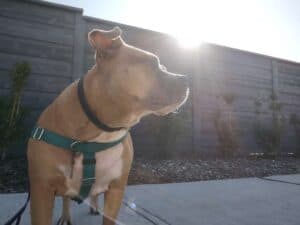From the beginning of Fur Services Fur Pets, we were a company that could work with canine anxiety without fear. Individually, I’ve always had a special knack for working with dogs that are anxious, fearful, and uncomfortable with new situations. As a company, we’ve spent years helping our clients with Separation Anxiety with their pups. Ironically, we just rescued a new dog, Penelope, and are working with her, firsthand, with her Separation Anxiety (you can catch the details of what we are going through starting with the first blog, A Journey to Overcoming Dog Separation Anxiety: My Personal Story, the Beginning.) As we work through this journey, we will be sharing with you this new blog series, Overcoming Separation Anxiety in Dogs: First Steps.
What is Separation Anxiety in Dogs?
Canine Separation anxiety is a behavioral disorder in dogs exhibiting extreme distress when a dog is separated from its owner or other sources of attachment (i.e. other dogs or comfort items). Most often, dogs with separation anxiety exhibit destructive behavior, excessive barking/whining, potty issues, and other signs of distress. Dogs with milder forms of separation anxiety are often clingy, follow their owners around or become unsettled when they are left alone. Often separation anxiety symptoms start mild and get more and more severe the longer it is left untreated.

Veterinarians, canine behaviorists, in-home pet care providers, and pet care facilities have seen an increase in Separation Anxiety since the onset of COVID-19 and the pandemic years that have kept owners at home around the clock with their pets.
Separation Anxiety is prevalent in both dogs and cats.
First Steps to Overcome Separation Anxiety
There is no simple fix for overcoming separation anxiety in dogs. It requires dedication, patience, and sometimes, backing up and trying something different. To combat anxiety, we generally recommend the following steps as an all-encompassing start to overcoming separation anxiety. (It’s important to note here that these are our opinions based on our experience with our clients and our pets and all recommendations should be considered with your veterinarian and/or dog behaviorist.)
- Set up cameras in your home. This step may make you feel uncomfortable if you don’t like the idea of having cameras around your house. Trust me, we get it! However, cameras can be one of the best tools in working through and assisting you to overcome your dog’s separation anxiety. It allows you to monitor their anxiety when you are not around. We use Amazon’s Blink Mini Indoor Cameras because they are compact, easy to unplug when we are home and don’t want cameras ‘on us,’ they are relatively affordable and the app is easy to use to check recordings.
- Determine if the anxiety is really separation anxiety or if there is an anxiety to something else. Is your dog not comfortable in their crate? Is your dog MORE comfortable in their crate? Is there noises outside your home that could be causing anxiety to your dog? Is your dog bored and not stimulated enough? Is your dog overstimulated?
- Make use of dog pheromone products. What are these dog pheromones? According to ADAPTIL,

- The top three pheromone products we recommend are: pheromone collar, pheromone plug-in diffuser and pheromone travel spray. Our favorite brands are Adaptil and ThunderEase.
- We recommend grabbing a collar and replacing it every thirty days. It can take a few days for you to start noticing a difference.
- The diffuser also lasts 30 days and we recommend, at the least, putting it next to their favorite dog bed, their crate or the place they enjoy hanging out while you are away. Having more than on is not a bad thing either! Ideally, they would be around the areas your dog is going to spend time while you are home and away.
- We recommend spraying a spritz or two of travel spray in your dog’s crate, their favorite bed, the sofa or on a bandana tied around their neck before you leave.
- For some dogs, incorporating canine pheromone products can reduce or eliminate mild forms of canine separation anxiety.
Once you have incorporated one, two or all three versions of canine pheromones above, we encourage you give it a week or two to monitor and assess the situation with your dog. This is where the cameras can come in handy. You can watch your dog live while away from home or watch the clips later and see what your dog is up to while you are away. This also allows you to monitor your dog’s anxiety threshold. (A simple definition of anxiety threshold is that ‘tipping point’ between your dog being calm and your dog over the edge with anxiety.)
Throughout this blog series, Overcoming Separation Anxiety in Dogs, we will continue covering more advanced steps to helping you and your best furry friend overcome their separation anxiety if they are needed for your Canine Separation Anxiety journey. We’ll also be sharing our experience and what we have done with our own rescue dog, Penelope! You can find our journey with her starting with The Beginning.
Is your dog under-stimulated or is overstimulation causing anxiety? Regular dog walking can reduce your dog’s anxiety naturally. Fur Services Fur Pets offers once-off or regular dog walking services. Check out our Dog Walking Options and Pricing, read Why We Should Walk Our Dogs, or review our Guide to Hiring a Dog Walker.
